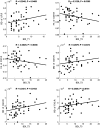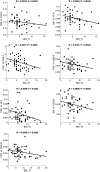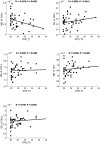Brain white matter development in 8-year-old children is associated with maternal mental health during pregnancy
- PMID: 40606496
- PMCID: PMC12213767
- DOI: 10.3389/fnhum.2025.1603022
Brain white matter development in 8-year-old children is associated with maternal mental health during pregnancy
Abstract
Background: Maternal mental health during pregnancy can influence fetal brain development, yet its long-term effects remain unclear. This study investigates the association between prenatal maternal depression and anxiety symptoms and white matter microstructure in the limbic system of 8-year-old children.
Methods: Fifty-one healthy pregnant women and typically developing 8-year-old children dyads were included in this prospective and longitudinal study. Maternal depression and anxiety symptoms were assessed at 12, 24, and 36 weeks of gestation using the Beck Depression Inventory-II (BDI-II) and State-Trait Anxiety Inventory (STAI). Their children underwent a brain MRI examination at age 8 years with multi-shell diffusion imaging analyzed using diffusion tensor imaging (DTI), diffusional kurtosis imaging (DKI), and neurite orientation dispersion and density imaging (NODDI) models for a multi-aspect evaluation of microstructural development. Key diffusion metrics (FA: fractional anisotropy; MD: mean diffusivity; AD: axial diffusivity; RD: radial diffusivity; MK: mean kurtosis; AK: axial kurtosis; RK: radial kurtosis; NDI: neurite density index; ODI: orientation dispersion index; FWF: free water fraction) were extracted from the limbic system white matter structures including cingulum, fornix, and uncinate fasciculus, which are closely associated with emotional and motivational processes.
Results: Higher maternal depression symptom scores were associated with lower FA (R = -0.3126, p = 0.0305, in CGH.R; R = -0.3025, p = 0.0366, in FXC.R) and MK (R = -0.3284, p = 0.0227, in CGG.R) and higher MD (R = 0.2879, p = 0.0472, in CGH.R) and RD (R = 0.3451, p = 0.0163, in CGH.R; R = 0.3456, p = 0.0161, in FXC.R) in predominately right-hemisphere limbic tracts. Higher maternal anxiety symptom scores were associated with increased MD (R = 0.2897, p = 0.0458, in FXC.L; R = 0.2859, p = 0.0488, in UF.L) and RD (R = 0.3168, p = 0.0283, in FXC.L), decreased NDI (R = -0.3787, p = 0.0079, in FXC.L; R = -0.3422, p = 0.0173, in UF.R), and increased AK (R = 0.3154, p = 0.029, in UF.L) in predominately left-hemisphere limbic tracts.
Conclusion: Our findings suggest that maternal depression and anxiety during pregnancy may have long-lasting impacts on offspring white matter microstructure maturation in the limbic system. This highlights the need for prenatal mental health screening and potential interventions to promote brain development and support optimal neurodevelopmental outcomes in children.
Keywords: children’s neurodevelopment; diffusion kurtosis imaging (DKI); diffusion tensor imaging (DTI); limbic system white matter; neurite orientation dispersion and density imaging (NODDI); prenatal maternal mental health.
Copyright © 2025 Huang, Koscik, Andres, Bellando, Glasier, Ram and Ou.
Conflict of interest statement
The authors declare that the research was conducted in the absence of any commercial or financial relationships that could be construed as a potential conflict of interest.
Figures








Similar articles
-
Unique information from common diffusion MRI models about white-matter differences across the human adult lifespan.Imaging Neurosci (Camb). 2023 Dec 21;1:imag-1-00051. doi: 10.1162/imag_a_00051. eCollection 2023. Imaging Neurosci (Camb). 2023. PMID: 40799710 Free PMC article.
-
Elucidating Microstructural Alterations in Neurodevelopmental Disorders: Application of Advanced Diffusion-Weighted Imaging in Children With Rasopathies.Hum Brain Mapp. 2024 Dec 1;45(17):e70087. doi: 10.1002/hbm.70087. Hum Brain Mapp. 2024. PMID: 39665502 Free PMC article.
-
The Effect of Prenatal Marijuana Exposure on White Matter Microstructure and Cortical Morphology During Late Childhood.AJNR Am J Neuroradiol. 2025 Apr 7:ajnr.A8774. doi: 10.3174/ajnr.A8774. Online ahead of print. AJNR Am J Neuroradiol. 2025. PMID: 40194858
-
Disentangling in-vivo microstructural changes of white and gray matter in mild cognitive impairment and Alzheimer's disease: a systematic review and meta-analysis.Brain Imaging Behav. 2023 Dec;17(6):764-777. doi: 10.1007/s11682-023-00805-2. Epub 2023 Sep 27. Brain Imaging Behav. 2023. PMID: 37752311
-
Translating state-of-the-art spinal cord MRI techniques to clinical use: A systematic review of clinical studies utilizing DTI, MT, MWF, MRS, and fMRI.Neuroimage Clin. 2015 Dec 4;10:192-238. doi: 10.1016/j.nicl.2015.11.019. eCollection 2016. Neuroimage Clin. 2015. PMID: 26862478 Free PMC article.
References
-
- Avants B. B., Tustison N., Song G. (2009). Advanced normalization tools (ANTS). Insight J. 2, 1–35. doi: 10.54294/uvnhin - DOI
-
- Bano W., Pulli E., Cantonas L., Sorsa A., Hämäläinen J., Karlsson H., et al. (2024). Implementing ABCD studyⓇ MRI sequences for multi-site cohort studies: practical guide to necessary steps, preprocessing methods, and challenges. MethodsX 12:102789. doi: 10.1016/j.mex.2024.102789, PMID: - DOI - PMC - PubMed
-
- Beck A. T., Steer R. A., Brown G. (1996). Beck depression inventory–II. United States: Psychological assessment.
-
- Belden A. C., Barch D. M., Oakberg T. J., April L. M., Harms M. P., Botteron K. N., et al. (2015). Anterior insula volume and guilt: neurobehavioral markers of recurrence after early childhood major depressive disorder. JAMA Psychiatry 72, 40–48. doi: 10.1001/jamapsychiatry.2014.1604, PMID: - DOI - PMC - PubMed
LinkOut - more resources
Full Text Sources
Miscellaneous

